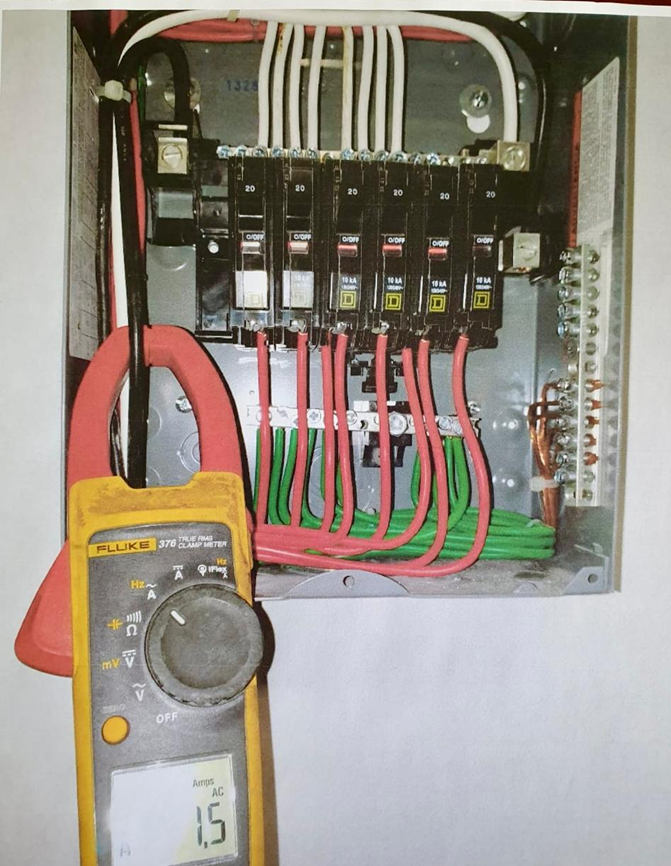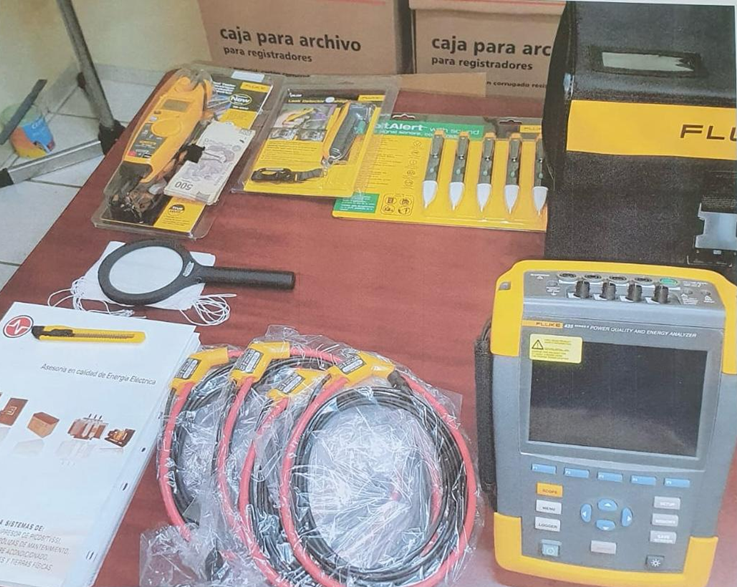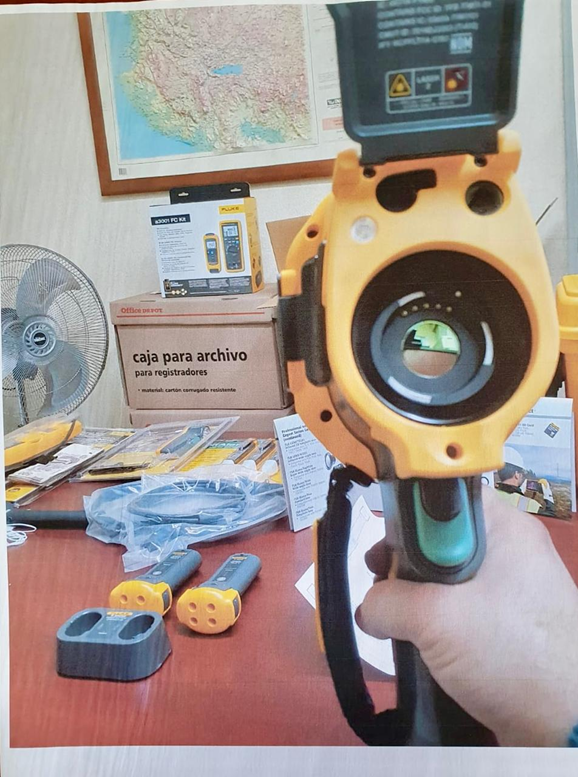Are you at risk? A quick quiz to determine your susceptibility to power problems…
Experience is your best indicator of whether a particular site is more or less at risk. Are your problems chronic (brownouts or blackouts several times a week), frequent (twice a month) or infrequent (one or two per year)?
Chronic (>12 per year) … 300
Frequent (>3 per year) … 80
Infrequent (< 3 per year) …50
Overloaded or poor wiring is a major cause of power problems. Wiring systems in many older buildings were not designed for and cannot tolerate the electrical demands of today’s equipment. If it’s more than 10 years old, it predates the arrival of laser printers and PCs, and is probably unable to support these power-hungry, sensitive loads.
Over 10 years…100
Over 5 years…80
Less than 5 years… 50
Underground distribution suffers fewer power problems than pole linked sources, which are subject to the hazards of tree branches, auto accidents, and curious animals.
Pole… 100
Underground… 10
Studies have shown that as much as 80% of power problems can be tied to the local environment. The innocent looking copy machine or laser printer may be responsible for data loss on your computer. An elevator on the other side of the wall may cause lockups every time a courier arrives.
Heavy machinery / motors…200
Copiers / Laser printers…150
The same lightning and surge events that cause damaging utility line transients can also cause power problems to reach your equipment through the «back door» on serial,
telephone/modem and LAN connections.
Modem, serial and network connection….200
Modem connection only…80
Unconnected stand-alone…50
Advanced network and multi-tasking operating systems depend on cache memory. This approach, while faster, is more volatile.
Network (NetWare, Win NT) ……100
Stand-alone multi-tasking (OS/2, Unix, Windows 95) ………..80
Stand-alone single tasking (DOS, Windows 3.1) ….50
As a network or multi-user system grows, the points of susceptibility also increase. The design of a LAN can also influence its susceptibility to power problems, as a cluster-oriented LAN may be unaffected by problems that bring down a LAN on a backbone.
More than 10 users….100
More than 5 users…….80
Less than 5 users.…50
Rural sites are notorious for bad power. As common-sense dictates, the farther power travels, the greater the chance of a disturbance along the way.
More than 200 miles…100
Less than 200 miles … 80
Lightning is perhaps the most dramatic reminder of the susceptibility of computers to damage and data loss.
However, lightning and surges go hand in hand with brownouts and blackouts.
The map at the left shows the annual number of days areas are expected to experience thunderstorms.
More than 30 annual storm days…300
More than 20 annual storm days…100
Less than 10 annual storm days…50
The map at left shows the electrical utility safery «cushions» in various areas of the United States. As populations grow and additional generating facilities aren’t built, rolling brownouts become a definite reality.
More than 10% under capacity…200
More than 5% under capacity…100
Less than 5% under capacity…80
Now simply add your total score.
Total………………………………
More than 1000: High risk
700 – 900: Above average risk
Less than 700: Average risk
Event # Start Time | Event | Extreme | End time/Duration/ degree |
0 05/03/2003 11:55:44 a.m. 54 05/03/2003 09:37:04 a.m. 53 05/03/2003 09:19:20 a.m. 52 04/03/2003 07:29:52 p.m. 51 05/03/2003 01:54:32 a.m. 50 05/03/2003 01:54:32 a.m. 49 05/03/2003 01:54:32 a.m. 48 05/03/2003 01:54:32 a.m. 47 04/03/2003 06:55:28 p.m. 46 04/03/2003 06:55:28 p.m. 45 04/03/2003 01:51:28 p.m. 44 04/03/2003 01:33:44 p.m. 43 04/03/2003 01:31:36 p.m. 42 04/03/2003 01:25:12 p.m. 41 04/03/2003 12:05:04 p.m. 40 04/03/2003 11:14:48 a.m. 39 04/03/2003 10:50:48 a.m. 38 04/03/2003 10:36:08 a.m. 37 03/03/2003 01:56:16 p.m. 36 02/03/2003 02:00:24 p.m. 35 02/03/2003 02:00:24 p.m. 34 02/03/2003 02:00:16 p.m. 33 02/03/2003 02:00:24 p.m. 32 02/03/2003 02:00:16 p.m. 31 01/03/2003 08:06:24 a.m. 30 01/03/2003 10:17:20 a.m 29 01/03/2003 10:17:20 a.m 28 01/03/2003 10: 7:20 a.m. 27 01/03/2003 09:13:52 a.m. 26 01/03/2003 09:13:52 a.m. 25 01/03/2003 09:13:32 a.M. 24 01/03/2003 08:06:24 a.m. 23 01/03/2003 07:42:56 a.m. 22 28/02/2003 01:44:00 p.m. 21 28/02/2003 01:10:40 p.m. 20 28/02/2003 12:41:12 a.m. 19 28/02/2003 12:36:08 a.m. 18 28/02/2003 12:35:44 a.m. 17 27/02/2003 04:07:20 p.m 16 27/02/2003 10:17:52 p.m. 15 27/02/2003 10:17:52 p.m. 14 27/02/2003 10:17:52 p.m. 13 27/02/2003 10:17:52 p.m. 12 27/02/2003 03:25:28 p.m. 11 27/02/2003 02:53:36 p.m. 10 27/02/2003 01:54:48 p.m. 9 26/02/2003 06:24:40 p.m. 8 27/02/2003 06:39:04 a.m. 7 27/02/2003 06:39:04 a.m. 6 27/02/2003 06:39:04 a.m. 5 27/02/2003 06:39:04 a.m. 4 26/02/2003 08:23:12 p.m 3 26/02/2003 08:23:12 p.m. 1 26/02/2003 08:23:12 p.m.
| Outage H-N Surge H-N Surge H-N Surge 8 N-G Impulses 8 N-G Impulses 8 H-N Impulses 8 H-N Impulses H-N Surge H-N Sag H-N Surge H-N Surge H-N Surge H-N Sag H-N Surge H-N Surge H-N Surge H-N Surge H-N Surge H-N Surge Low Frequency Outage Low Frequency Low Frequency H-N Surge 10 N-G Impulses 10 H-N Impulses 10 H-N Impulses 1 N-G Impulse 1 H-N Impulse 1 H-N Impulse H-N Surge H-N Surge H-N Surge H-N Surge H-N Surge H-N Surge H-N Surge H-N Surge 1 N-G Impulse 1 N-G Impulse 1 H-N Impulse 1 H-N Impulse H-N Surge H-N Surge H-N Surge H-N Surge 1 N-G Impulse 1 N-G Impulse 1 H-N Impulse 1 H-N Impulse 17 N-G Impulses 17 N-G Impulses 17 H-N Impulses 17 H-N Impulses
| 0 Vms 130 Vms 130 Vms 138 Vms +130 Vp -110 VP + 370 VP -330 VP 131 Vrms 96 Vrms 132 Vrms 129 Vrms 129 Vrms 129 Vrms 129 Vrms 103 Vrms 129 Vrms 129 Vrms 129 Vrms 129 Vrms 137 Vrms 140 Vrms 52.5 Hz 0 Vrms 52. 5 Hz 52. 5 Hz 140 Vms +120 Vp +240 Vp -250 Vp +110 Vp +230 Vp -210 Vp 133 Vrms 135 Vrms 137 Vrms 129 Vrms 136 Vrms 134 Vrms 134 Vrms 135 Vrms +200 Vp -180 Vp +380 Vp -410 Vp 129 Vrms 130 Vrms 136 Vrms +130 Vp -110 Vp +290 Vp +130 Vp -120 Vp +280 Vp -310 Vp | Open Event 00:57:28 00:14:00 13:49:28 214° 214° 214° 214° 00:34:32 1.0 cycles 05:04:08 00:02:22 41.6 seconds 1.0 cycles 73.5 seconds 00:20:40 00:23:52 22.8 seconds 20:40:00 21:34:24 3.0 cycles 00:00:16 1.0 cycles 00:05:44 02/03/2003 02:00:24 p.m. 26° 26° 26° 207° 207 207° 5.0 seconds 00:23:28 17:59:04 00:27:52 10:46:32 00:05:02 23.3 seconds 08:28:32 38° 38° 38° 38° 2.9 seconds 00:23:44 00:46:56 16:41:20 212° 212° 212° 212° 33° 33 33 33° |
México, 24 Ene (Notimex). – Los vientos de hasta 70 kilómetros por hora que «golpearon» durante la tarde y noche del miércoles en Ciudad de México, mantienen sin luz a 25 colonias donde ha sido necesario reforzar los patrullajes para evitar actos de vandalismo.
De acuerdo con reportes de la Secretaría de Seguridad Pública del Ciudad de México (SSPDF), la caída de 32 alimentadores de la Compañía de Luz y Fuerza del Centro provocaron que no haya energía eléctrica en varias colonias, situación que podría tardar en resolverse hasta 48 horas.

DURANGO.- Los torrenciales aguaceros y tormentas eléctricas registradas en Durango y Laca-tecas provocaron el corte de energía eléctrica en al menos seis municipios, y ocasionaron daños materiales en viviendas, calles y caminos.
En Durango, la capital fue la más afectada por la tromba, ya que además de que 50% de la población se quedó sin el suministro de energía eléctrica porvarias horas, se registraron inundaciones en nueve colonias y el derrumbe de 80 árboles, informó Alberto Castro Rochel, director de Protección Civil municipal, y añadió que se implementó un plan de emergencia.
Por su parte, la Dirección de Protección Civil en Zacatecas reportó que una tormenta eléctrica ocasionó el corte de energía en cinco municipios del Sureste del Estado. El servicio de luz estuvo interrumpido durante casi una hora.
Los municipios de Ojocaliente y Pánfilo Natera resultaron los más afectados con las intensas lluvias registradas en las últimas horas, aunque no se reportaron daños en viviendas ni pérdidas humanas.
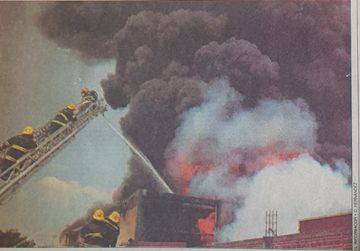
CANCUN. – El apagón que afectó la Península de Yucatán se resintió también en la zona hotelera de Cancún, donde solamente algunos hoteles cuentan con sus propias plantas generadoras de energía.
MÉRIDA. – El apagón registrado de potencial y de aislamiento de la madrugada de ayer martes en conocido como barras conectoras la Península de Yucatán ocasiono generales.
Afectaciones aún no evaluadas a la El Gobierno de Yucatán informó
industria maquiladora y turística, que en cuanto se tuvo conocida suspensión del servicio de agua por el miento del apagón, la Secretaría da miles de usuarios, hasta por Protección y Vialidad habilitó nueve horas, así como retraso en la en comercios que abren di venta de combustible.
Durante las 24 horas, así como en hora para el superintendente de la pitales e industrias Comisión Federal de Electricidad en esta Entidad federativa
(CFE) del Sur de Quintana Roo, mayores pérdidas las registró la sé García Martel, la causa de la industria maquiladora, ya que el apagón que afectó a Campeche, Quintana roo mayoría de las plantas trabajan tu tana Roo y Yucatán se ubicó en los nocturnos, aunque será en su estación, Yucatán, luego tres días cuando se conozca a de que un rayo dañó un dispositivo ascienden.

Basic Solution: Protection from three potential problems

Power Failure. Power. Sag.
Surge.
The Powerware Series 3 UPS primarily protects against three of the nine power problems including power failures, power sags and power surges. This essential, cost-effective protection is necessary in order to prevent damage such as data loss, file corruption, flickering lights, hardware damage, and equipment shutoff. For example, if your utility fails you could lose all of your work-in-progress.
The series 3 UPS offers a degree of protection against the remaining power problems and is most commonly used protect single workstation and point-of-sale (POS) equipment.
Intermediate Solution: Protection from five potential problem.

Power Failure. Powe Sag. Power Surge. Under-voltage. Over-voltage.
Powerware Series 5 UPSs are most effective against five power problems (power failures, power sags, power surges, under-voltage and over-voltage) and offer a degree of protection against other power problems. Some of the damages you risk by not using a Series 5 UPS include premature hardware failure, data loss and corruption, data error, keyboard lockup, storage loss, and system lockup. Series 5 UPSs are recommended for small network systems-all the way up to enterprise networking environments.
Complete Solution: Protection from all nine potential problems.

Power Failure. Powe Sag. Power Surge. Under-voltage. Over-voltage. Line Noise. Frequency Variation. Switching Transient. Harmonic Distortion.
Powerware Series 9 UPSs protect against all nine power problems: power failures, power sags, power surges, under-voltage, electrical line noise, over-voltage, frequency variation, switching transients, and harmonic distortion. Powerware Series 9 comprehensive protection minimizes the opportunity for component stress, burned circuit boards, data crashes and program failures. Series
9 UPSs offer the highest level of power protection available and are always recommended for mis-sion-critical applications like server farms, hospitals, and VOIP applications.

| Point1 | Point2 | Point3 | Line4 |
Emiss. | 0.95 | 0.95 | 0.95 | 0.95 |
Avg |
|
|
| 31.8°C |
Min |
|
|
| 24.6°C |
Max | 44.0 °C | 43.4 °C | 36.1°C | 43.2°C |
Delta |
|
|
|
|


Calentamiento en conexión de cable a interruptor (I=33 amp)
Recomendaciones: Verificar apriete de conexiones y revisar cálculo de conductores (capacidad de cable cal. 10 AWG es 30 amp)
Inspeccionó: Ing. Jaime Gómez Godínez

IEEE (Institute of Electrical and Electronics Engineers)
NEC (National Electrical Code)
FIPS (US National Bureau of Standards)
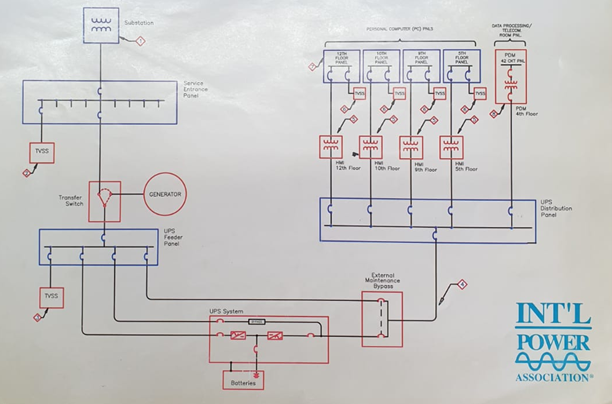
Seguridad de Equipos y Usuarios
Infra estructura Eléctrica 25 puntos
Verificación de Sistemas de Puesta a Tierra
Unión Electrodo/Conductor
Calibre de Cable de Puesta a Tierra
Mantenimiento Acceso a Electrodo
Mantenimiento Acceso a área de influencia
Sistema Equipotencial
Verificación de Conductores Eléctricos
Calibre Adecuado
Estado Físico del Aislante
Verificación de Interruptores Electromagnéticos y Estado Físico de los Tableros Eléctricos
Correcto Dimensionamiento de ITM
Aterrizamiento de Chasis de Tableros
Aislamiento de barra de Neutro en tablero
Limpieza, mantenimiento y estado general del tablero eléctrico
Protección contra Transitorios de Voltaje 25 puntos
Verificación de la existencia de supresor de picos y voltajes transitorios
Correcta instalación del supresor para garantizar su funcionamiento
Correcto dimensionamiento de la capacidad del supresor
Protección seriada o Cascadeo según recomendación de la EEE
Disponibilidad del Suministro Eléctrico
Calidad de la Energía 25 puntos
Nivel de voltaje en Acometida (Regulación)
Aislamiento Magnético
Armónicas
Confiabilidad y Continuidad del Suministro 25 puntos
Años de Operación de UPS y Banco de Baterías
Redundancia en UPS
Redundancia en Banco de Baterías
Línea de Suministro de Energía alternativo para Mantenimiento
Tecnología del UPS
Planta de Emergencia
Monitoreo Local con capacidad de aviso remoto

CATEGORY | CATEGORY C | CATEGORY B | CATEGORY A |
EXAMPLE | * SECONDARY POWER DROP * SERVICE ENTRANCE * OVERHEAD BRANCH CIRCUITS TO DETACHED BUILDINGS | · SUBPANELS · BUSES AND FEEDERS · HARDWIRED EQUIPMENT | · OUTLET AND LONG BRANCH CIRCUITS |
CHARACTERISTIC SURGE | * 20.000 VOLTS DELIVERING * 10,000 AMPS FOR APPROXIMATELY * 20 MICROSECONDS (10KA, 8/20us BI WAVE FROM 2л. SOURCE IMPEDANCE) | · 6.000 VOLTS DELIVERING · 3,000 AMPS FOR APPROXIMATELY · 20 MICROSECONDS (3kA, 8/20us BI WAVE FROM 2л SOURCE IMPEDANCE) |

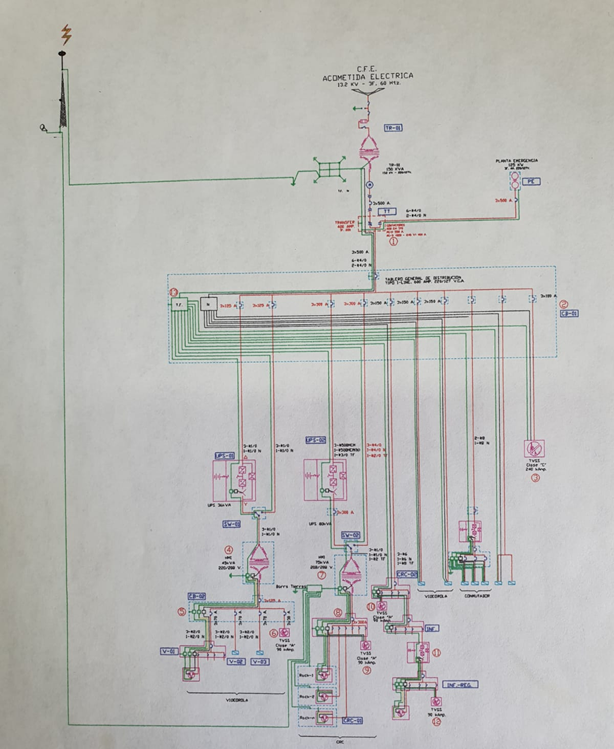

Defined by ANSI/lEEE C62.41 (1991) IEEE Recommended Practice on Surge Voltages in Low-Voltage AC Power Circuits, as representative of high exposure installations.
